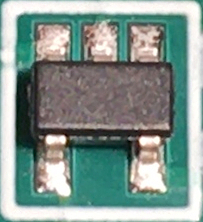
A Beowulf cluster is a computer cluster of what are normally identical, commodity-grade computers networked into a small local area network with libraries and programs installed which allow processing to be shared among them. The result is a high-performance parallel computing cluster from inexpensive personal computer hardware.
In computing, the Global File System 2 or GFS2 is a shared-disk file system for Linux computer clusters. GFS2 allows all members of a cluster to have direct concurrent access to the same shared block storage, in contrast to distributed file systems which distribute data throughout the cluster. GFS2 can also be used as a local file system on a single computer.

A watchdog timer, sometimes called a computer operating properly timer, is an electronic or software timer that is used to detect and recover from computer malfunctions. Watchdog timers are widely used in computers to facilitate automatic correction of temporary hardware faults, and to prevent errant or malevolent software from disrupting system operation.

QEMU is a free and open-source emulator. It emulates a computer's processor through dynamic binary translation and provides a set of different hardware and device models for the machine, enabling it to run a variety of guest operating systems. It can interoperate with Kernel-based Virtual Machine (KVM) to run virtual machines at near-native speed. QEMU can also do emulation for user-level processes, allowing applications compiled for one architecture to run on another.
The Linux-HA project provides a high-availability (clustering) solution for Linux, FreeBSD, OpenBSD, Solaris and Mac OS X which promotes reliability, availability, and serviceability (RAS).

DRBD is a distributed replicated storage system for the Linux platform. It is implemented as a kernel driver, several userspace management applications, and some shell scripts. DRBD is traditionally used in high availability (HA) computer clusters, but beginning with DRBD version 9, it can also be used to create larger software defined storage pools with a focus on cloud integration.
Apache Hadoop is a collection of open-source software utilities that facilitates using a network of many computers to solve problems involving massive amounts of data and computation. It provides a software framework for distributed storage and processing of big data using the MapReduce programming model. Hadoop was originally designed for computer clusters built from commodity hardware, which is still the common use. It has since also found use on clusters of higher-end hardware. All the modules in Hadoop are designed with a fundamental assumption that hardware failures are common occurrences and should be automatically handled by the framework.
The Red Hat Cluster includes software to create a high availability and load balancing cluster. Both can be used on the same system although this use case is unlikely. Both products, the High Availability Add-On and Load Balancer Add-On, are based on open-source community projects. Red Hat Cluster developers contribute code upstream for the community. Computational clustering is not part of cluster suite, but instead provided by Red Hat MRG.
A clustered file system (CFS) is a file system which is shared by being simultaneously mounted on multiple servers. There are several approaches to clustering, most of which do not employ a clustered file system. Clustered file systems can provide features like location-independent addressing and redundancy which improve reliability or reduce the complexity of the other parts of the cluster. Parallel file systems are a type of clustered file system that spread data across multiple storage nodes, usually for redundancy or performance.
Oracle Clusterware is the cross-platform cluster software required to run the Real Application Clusters (RAC) option for Oracle Database. It provides the basic clustering services at the operating-system level that enable Oracle Database software to run in clustering mode. In earlier versions of Oracle, RAC required a vendor-supplied clusterware like Sun Cluster or Veritas Cluster Server.

Fencing is the process of isolating a node of a computer cluster or protecting shared resources when a node appears to be malfunctioning.

A computer cluster is a set of computers that work together so that they can be viewed as a single system. Unlike grid computers, computer clusters have each node set to perform the same task, controlled and scheduled by software. The newest manifestation of cluster computing is cloud computing.
Nano-RK is a wireless sensor networking real-time operating system (RTOS) from Carnegie Mellon University, designed to run on microcontrollers for use in sensor networks. Nano-RK supports a fixed-priority fully preemptive scheduler with fine-grained timing primitives to support real-time task sets. "Nano" implies that the RTOS is small, using 2 KB of random-access memory (RAM) and using 18 KB of flash memory, while RK is short for resource kernel. A resource kernel provides reservations on how often system resources can be used. For example, a task might only be allowed to execute 10 ms every 150 ms, or a node might only be allowed to transmit 10 network packets per minute. These reservations form a virtual energy budget to ensure a node meets its designed battery lifetime and to prevent a failed node from generating excessive network traffic. Nano-RK is open-source software, is written in C and runs on the Atmel-based FireFly sensor networking platform, the MicaZ motes, and the MSP430 processor.

An application programming interface (API) is a way for two or more computer programs or components to communicate with each other. It is a type of software interface, offering a service to other pieces of software. A document or standard that describes how to build or use such a connection or interface is called an API specification. A computer system that meets this standard is said to implement or expose an API. The term API may refer either to the specification or to the implementation. Whereas a system's user interface dictates how its end-users interact with the system in question, its API dictates how to write code that takes advantage of that system's capabilities.

The Slurm Workload Manager, formerly known as Simple Linux Utility for Resource Management (SLURM), or simply Slurm, is a free and open-source job scheduler for Linux and Unix-like kernels, used by many of the world's supercomputers and computer clusters.
cgroups is a Linux kernel feature that limits, accounts for, and isolates the resource usage of a collection of processes.

OpenShift is a family of containerization software products developed by Red Hat. Its flagship product is the OpenShift Container Platform — a hybrid cloud platform as a service built around Linux containers orchestrated and managed by Kubernetes on a foundation of Red Hat Enterprise Linux. The family's other products provide this platform through different environments: OKD serves as the community-driven upstream, Several deployment methods are available including self-managed, cloud native under ROSA, ARO and RHOIC on AWS, Azure, and IBM Cloud respectively, OpenShift Online as software as a service, and OpenShift Dedicated as a managed service.
In computer science, a heartbeat is a periodic signal generated by hardware or software to indicate normal operation or to synchronize other parts of a computer system. Heartbeat mechanism is one of the common techniques in mission critical systems for providing high availability and fault tolerance of network services by detecting the network or systems failures of nodes or daemons which belongs to a network cluster—administered by a master server—for the purpose of automatic adaptation and rebalancing of the system by using the remaining redundant nodes on the cluster to take over the load of failed nodes for providing constant services. Usually a heartbeat is sent between machines at a regular interval in the order of seconds; a heartbeat message. If the endpoint does not receive a heartbeat for a time—usually a few heartbeat intervals—the machine that should have sent the heartbeat is assumed to have failed. Heartbeat messages are typically sent non-stop on a periodic or recurring basis from the originator's start-up until the originator's shutdown. When the destination identifies a lack of heartbeat messages during an anticipated arrival period, the destination may determine that the originator has failed, shutdown, or is generally no longer available.
Docker is a set of platform as a service (PaaS) products that use OS-level virtualization to deliver software in packages called containers. The service has both free and premium tiers. The software that hosts the containers is called Docker Engine. It was first released in 2013 and is developed by Docker, Inc.
Kubernetes is an open-source container orchestration system for automating software deployment, scaling, and management. Originally designed by Google, the project is now maintained by a worldwide community of contributors, and the trademark is held by the Cloud Native Computing Foundation.








